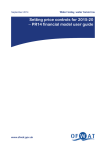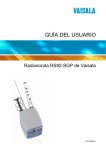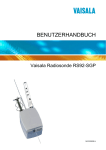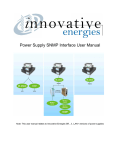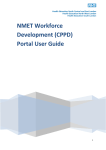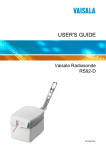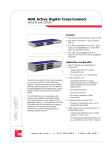Download Risk-based review cost assessment summary – user guide
Transcript
April 2014 Water today, water tomorrow Risk-based review cost assessment summary – user guide www.ofwat.gov.uk Risk-based review cost assessment summary – user guide Contents 1. Introduction 2 2. Scores 3 3. Gaps between business plans and the risk-based review cost thresholds 4 4. Business plan spending for 2015-20 compared to 2010-15 5 5. Composition of cost thresholds 6 6. Items subject to deep dive assessment but not added to cost thresholds 9 1 Risk-based review cost assessment summary – user guide 1. Introduction 1.1 This document explains the key features of the cost assessment summary tables – which show the basic cost threshold (BCT) for each company and the main adjustments made in the risk-based review to allow the calculation of the initial risk-based review cost thresholds. 1.2 The summary tables also provide an overview of the main items where an adjustment was considered but rejected, typically on the basis of insufficient evidence in company business plans or because our analysis suggests that there is adequate allowance in the BCT for the item in question. 1.3 The spreadsheet is divided into five sections as follows: scores; gaps between business plans and the risk-based review cost thresholds; business plan spending in 2015-20 compared to 2010-15; composition of cost thresholds; and items subject to deep dive assessment but not added to cost thresholds. 1.4 Each is explained in turn below. 2 Risk-based review cost assessment summary – user guide 2. Scores 2.1 This section sets out each company’s overall score for the wholesale cost test, and its score on the individual criteria (quality of evidence and position in relation to the cost threshold). 2.2 A summary of the risk-based review wholesale cost assessment test is set out on page 28 of Setting price controls for 2015-20 – pre-qualification decisions and is not repeated here. The only additional information included in the summary is that it indicates where we have applied regulatory judgement in reaching a final view of the wholesale cost score, rather than relying on a mechanistic interpretation of the scoring guidelines. 3 Risk-based review cost assessment summary – user guide 3. Gaps between business plans and the risk-based review cost thresholds 3.1 This section shows the totex contained in company business plans and the various Ofwat initial risk-based review cost thresholds, and quantifies the extent of the gap between business plan totex and the key Ofwat initial risk-based review threshold – that is the boundary between a B and C score in the efficiency criteria test. 3.2 Where the gap to B/C column is negative this indicates that a company’s planned level of totex is below that of our B/C threshold. 3.3 The totex totals are taken from tables W1 and S1 of company business plans. 4 Risk-based review cost assessment summary – user guide 4. Business plan spending for 2015-20 compared to 2010-15 4.1 This section compares the forecast level of totex contained in company business plans for 2015-20 with their projected level of expenditure in 2010-15. 4.2 Data for 2010-13 was mainly sourced from the August 2013 wholesale cost data submission, with the accounting separation return for 2012-13 used to provide wholesale sewerage opex for this year. Data for 2013-14 and 2014-15 was sourced from company business plans – tables W12 and S12. 5 Risk-based review cost assessment summary – user guide 5. Composition of cost thresholds 5.1 This section shows the changes that were made in the risk-based review to BCTs to derive the initial risk-based review B/C threshold. In particular it sets out: model thresholds (BCTs); policy additions; unmodelled costs delta; national environment programme phase 5 and private sewer pumping stations (sewerage only); and deep dive items. 5.2 Each is discussed in turn below. Model thresholds (BCTs) 5.3 The model thresholds or BCTs represent the results of our modelling approaches, which are described in the basic cost threshold model. Policy additions 5.4 Policy additions represent additional costs for items which were excluded from our cost assessment models, but which need to be included in the risk-based review threshold in order to allow proper comparisons with business plan totex forecasts. Five types of costs are included. Business rates: this figure represents our estimate of the costs companies included in their plans. In the light of the risk and reward guidance we decided to neutralise the impact of business rates on the cost comparisons by including a matching assumption with business plans in the cost threshold. Pension deficit: this constitutes the “allowance” for these costs as set out in IN 13/17: Treatment of companies’ pension deficit repair costs at the 2014 price review, plus an adjustment for both continuing and catch-up efficiency from the 2009 price review. Third party costs: this represents our estimate of the amounts included by companies within their business plans, calculated as follows: – companies were asked to show third party revenue figures separately within business plans, but not costs; and 6 Risk-based review cost assessment summary – user guide – consequently, to calculate the approximate level of third party costs included within business plans we worked out company specific average historical margins separately for water and sewerage, and applied these to business plan third-party revenue projections. Open market costs: these costs were taken from the midpoint costs contained in the letter dated 28 October 2013 from Sonia Brown to companies, then apportioned between companies on the basis of eligible non-household customer numbers. No costs were included for companies that operate wholly within Wales. Net compared to gross adjustment: this adjustment reflects different accounting treatment by companies of some receipts from infrastructure and connection charges: – our models were built using historical company data, within which the predominant treatment of receipts in respect of infrastructure and connections charges was to net them off capex – therefore our models were built on a net basis; – however, a number of companies now adopt a gross approach for at least part of these receipts, and show them as revenue rather than netting them off capex; and – so that our thresholds would be comparable with business plans, for those companies that adopt a gross approach we increased our threshold to include those elements of infrastructure and connection charges which companies treated as revenue and did not net off from their business plan capex forecasts. 5.5 A breakdown of the policy additions split into these five types of cost for each company is provided with this document. Unmodelled costs delta 5.6 As described in the basic cost threshold model, BCTs include a generic uplift for unmodelled costs, for certain enhancement costs which we were unable to otherwise model or include in our bottom-up approach to estimating the thresholds. 5.7 That same document explains how we subsequently adjusted the figures for unmodelled costs, which represent the figures shown in this column. In the case of sewerage, because only the bottom-up modelling approach is used, 100% of the adjustment feeds through to the initial risk-based review threshold, whereas in water, due to the one third weight of the bottom-up modelling approach in the triangulation, only 33% feeds through. 7 Risk-based review cost assessment summary – user guide 5.8 Finally in this column, where companies have not been allowed all the unmodelled costs in their business plans (after our reallocations), we note the maximum potential additional level of allowance. National environment programme phase 5 and private sewer pumping stations (sewerage only) 5.9 Costs associated with the national environment programme phase 5 and private sewer pumping stations are not included within the BCTs but are added subsequently. 5.10 The approaches to calculating the amounts are described in appendices 1 and 2 of the wholesale risk-based review template model. Deep dive items 5.11 The final set of adjustments is in respect of items given special treatment in cost assessment following our deep dive assessments. The approach to these is described in the wholesale risk-based review template model. 5.12 Items are added net of any allowance we have estimated as already implicit in the BCT for the item concerned – that is net of the implicit allowance (IA). 5.13 Items are shown with a pink background if the company included them within a claim for special treatment in respect of cost assessment in tables W11 or S11 of their business plans. 8 Risk-based review cost assessment summary – user guide 6. Items subject to deep dive assessment but not added to cost thresholds 6.1 This section summarises up to four items per company which were subject to a deep dive assessment but where we decided not to adjust the cost threshold. Three lines of information are shown for each item: the name of the item; the gross amount of the item and amount net of any implicit allowance; and the reason for not passing the deep dive, which could be: – insufficient evidence; – covered by implicit allowance; – materiality that is, where the net amount of the item is under 0.5% of plan totex; – in models that is, where an item is in principle within the models, but no implicit allowance has been calculated. 6.2 Items marked with a single asterisk fall into the unmodelled costs category. 9 Ofwat Centre City Tower 7 Hill Street Birmingham B5 4UA Phone: 0121 644 7500 Fax: 0121 644 7533 Website: www.ofwat.gov.uk Email: [email protected] April 2014 © Crown copyright 2014 You may reuse this information (excluding logos) free of charge in any format or medium, under the terms of the Open Government Licence v2.0. To view this licence, visit http://www.nationalarchives. gov.uk/doc/open-government-licence/version/2 or email [email protected]. Where we have identified any third party copyright information, you will need to obtain permission from the copyright holders concerned. Any enquiries regarding this publication should be sent to us at [email protected]. This document is also available from our website at www.ofwat.gov.uk.











